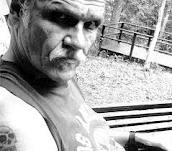On March 28, 2012, the South lost one of its most remarkable, most creative, greatest, crudest, weirdest writers: Harry Crews. He would have celebrated his 77th birthday on June 7.
Crews was born and raised in a rural, economically underdeveloped part of Bacon County, Georgia. He was perhaps best known for writing about “freaks.” His characters are usually physically deformed, almost always psychologically damaged, and all too often engage in behavior considered “deviant” by certain standards. The older brother of the titular character from The Gospel Singer (1968), for example, is afflicted with a disfiguring skin condition and as such considers joining a local freak show. In Car (1972), Herman Mack travels to Jacksonville, Florida, in order to eat a Ford Maverick—bit by bit—while being broadcast live on television. In a similar spectacle, Shereel Dupont, the female bodybuilding protagonist of Body (1990), transforms her once slender physique into a grotesque mountain of muscles in an effort to be crowned Ms. Cosmos. Although Crews’s characters may not “operate within conventional moral boundaries,” as an article in The Daily Telegraph points out, they still manage to “become heroic by fighting to maintain their dignity against the odds, drawing on reserves of black humour to keep themselves going.”
Apart from “freaks,” Crews’s novels are also characterized by their gratuitous violence. However, for many of Crews’s subversive characters (who often suffer crises of identity or struggle to adapt to their changing surroundings), that violence often becomes a way of organizing experience, of finding meaning by inflicting pain on themselves and others. Former high school football star Joe Lon Mackey, in A Feast of Snakes (1976), is one such character who has difficulty making sense of his adult world and goes on a shooting rampage while at Mystic, Georgia’s annual Rattlesnake Roundup. John Kaimon, the protagonist in Karate is a Thing of the Spirit (1971), finds sanctuary in joining a sort of “fight club,” while Eugene Biggs, in The Knockout Artist (1988), masters and exploits the trick of knocking himself out with a single punch to the jaw.
In Blood and Grits (1979), a collection of essays and stories originally published in Esquire, Crews admits that much of his writing was born “out of a fear and loathing for what I was and who I was.” His affinity for writing about violence and marginalized peoples, he suggests, is deeply rooted in his own experiences. In the documentary Searching for the Wrong-Eyed Jesus (2003), Crews remembers his childhood fascination with looking through the Sears Roebuck catalogue. “First thing that struck us,” he says in his characteristic growl, “was that everybody in the Sears Roebuck catalogue was perfect. Wasn’t any bald heads. Everybody had all the fingers that was comin’ to ‘em. Nobody had any open and running sores on their bodies. But everybody we knew had a finger missin’ or one eye put out from a staple glancin’ off a post…In our world, everybody was maimed and mutilated.”
This world Crews describes is one he knew all too well. In his memoir, A Childhood: The Biography of a Place (1978), he recalls “how lonely and savage it was to be a freak” when he was crippled by disease at only five years old. His illness (which was likely polio) caused his legs to cramp and shrivel. “They were bent at the knees, and the ligaments were slowly drawing my heels closer and closer to the cheeks of my buttocks,” he writes. “It felt like both legs were knotted from hip to heel.” The following year, shortly after regaining his ability to walk, Crews sustained severe burns to over two-thirds of his body when he was accidentally thrown into a cast-iron vat full of boiling water. It would take him another year to recover from those injuries.
Crews’s personal life—the culture of his region and his own peculiar upbringing—not only informed his writing, but also helped instill in him the value of storytelling. “Stories was everything and everything was stories,” he claimed. “Everybody told stories. It was a way of saying who they were in the world. It was their understanding of themselves. It was letting themselves know how they believed the world worked, the right way and the way that was not so right.” After three years of serving as a Marine in the Korean War, he attended the University of Florida to pursue his interest in writing. Two years later, he dropped out in order to ride across the country on a Triumph motorcycle, where his real-life experiences continued to be as strange as those depicted in his fiction. Over the course of his eighteen-month travels, Crews became part of a carnival sideshow, worked as a bartender and short order cook, spent time in jail in Wyoming, and was “beaten in a fair fight by a one-legged Blackfoot Indian” while in Montana.
He eventually returned to UF, where he earned his Bachelor’s degree in Literature and his Master’s in English Education. In 1968—after travelling, marrying, divorcing, remarrying, witnessing the birth of two sons and the unfortunate death of one—he again returned to UF to teach in the Creative Writing program. Crews served as an integral part of the university’s faculty until he retired in 1997.
As Matthew Guinn writes, Crews was “one of the foremost contemporary practitioners of the southern grotesque.” What’s more, Crews almost undoubtedly has helped and continues to help shape the genre into what it is today. In his time he published over fifteen novels, including The Hawk is Dying (1973), The Gypsy’s Curse (1974), Scar Lover (1992), The Mulching of America (1995), Celebration (1998), and An American Family: The Baby with the Curious Markings (2006). He also published two collections of non-fiction essays—Classic Crews: A Harry Crews Reader (1993) and The Gospel Singer & Where Does One Go When There’s No Place Left to Go? (1995)—as well as an autobiography and various other essays and collections. His work will forever serve as a testament to his impressive influence.

Leave a Reply